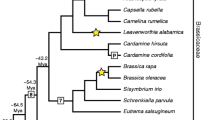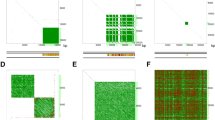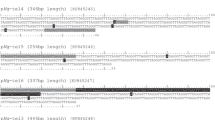Abstract
The genus Cestrum in the Solanaceae family is unusual in lacking Arabidopsis-type telomeres (TTTAGGG)n, although short interstitial telomeric sequences (ITSs) occur scattered throughout the genome in both orientations. To isolate candidate telomeric sequences in Cestrum we assumed that some of the ITSs were residues of the original telomeres and that they may still be located in the vicinity of present-day telomeres. Three sequence types associated with ITSs were cloned and characterized; these were termed NA3G, BR23 and A/T-rich minisatellite. These high copy number sequences are dispersed across the genome and clustered at a number of chromosomal loci. Their association with ITSs, which can act as recombination hotspots, might indicate past recombination and chromosomal fusion events, processes that may have contributed to the large size of Cestrum chromosomes. The sequences are frequently arranged as NA3G-ITS-BR23 blocks embedded in an A/T-rich minisatellite array. The A/T-rich minisatellite is of particular interest because the consensus 5′-T4–5AGCAG-3′ might be a derivative of “typical” eukaryotic telomeric sequence motifs. The sequence is abundant at the end of some chromosomes in C. parqui and is found not only in Cestrum but also in the closely related genera Sessea and Vestia, which also lack Arabidopsis-type telomeric sequences. However, the sequence is absent from the Solanaceae genera investigated that are outside the group, including the closely related genus Streptosolen, which all have the Arabidopsis-type telomere. The data indicate that the A/T rich minisatellite might have evolved in response to the loss of Arabidopsis-type telomeres.







Similar content being viewed by others
References
Adams SP, Hartman TPV, Lim KY, Chase MW, Bennett MD, Leitch IJ, Leitch AR (2001) Loss and recovery of Arabidopsis-type telomeric repeat sequences 5′-(TTTAGGG)n-3′ in the evolution of a major radiation of flowering plants. Proc R Soc London B Biol Sci 268:1541–1546
Ashley T, Ward DC (1993) A hot spot of recombination coincides with an interstitial telomeric sequence in the Armenian hamster. Cytogenet Cell Genet 62:169–171
Azzalin CM, Nergadze SG, Giulotto E (2001) Human intrachromosomal telomeric-like repeats: sequence organization and mechanisms of origin. Chromosoma 110:75–82
Berg C, Greilhuber J (1992) Cold sensitive chromosome regions and their relation to constitutive heterochromatin in Cestrum parqui (Solanaceae). Genome 35:921–930
Berg C, Greilhuber J (1993a) Cold sensitive regions and heterochromatin in Cestrum aurantiacum (Solanaceae). Plant Syst Evol 185:259–273
Berg C, Greilhuber J (1993b) Cold sensitive regions and heterochromatin in Cestrum (Solanaceae): C. strigillatum, C. fasciculatum, and C. elegans. Plant Syst Evol 185:133–151
Biessmann H, Mason JM (1997) Telomere maintenance without telomerase. Chromosoma 106:63–69
Biessmann H, Zurovcova M, Yao JG, Lozovskaya E, Walter MF (2000) Chromosoma A telomeric satellite in Drosophila virilis and its sibling species. Chromosoma 109:372–380
Bolshoy A, McNamara P, Harrington RE, Trifonov EN (1991) Curved DNA without A-A: experimental estimation of all 16 DNA wedge angles. Proc Natl Acad Sci USA 88:2312–2316
Bryan TM, Englezou A, Dalla-Pozza L, Dunham MA, Reddel RR (1997) Evidence for an alternative mechanism for maintaining telomere length in human tumors and tumor-derived cell lines. Nat Med 3:1271–1274
Cheung WY, Money TA, Abbo S, Devos KM, Gale MD, Moore G (1994) A family of related sequences associated with (TTTAGGG)n repeats are located in the interstitial regions of wheat chromosomes. Mol Gen Genet 245:349–354
Dellaporta SL, Wood J, Hicks JB (1983) A plant DNA minipreparation: version II. Plant Mol Biol Reporter 4:19–21
Dhar MK, Friebe B, Koul AK, Gill BS (2002) Origin of an apparent B chromosome by mutation, chromosome fragmentation and specific DNA sequence amplification. Chromosoma 111:332–340
Fajkus J, Kovarik A, Kralovics R, Bezdek M (1995) Organization of telomeric and subtelomeric chromatin in the higher plant Nicotiana tabacum. Mol Gen Genet 247:633–638
Fernandez JL, Gosalvez J, Goyanes V (1995) High frequency of mutagen-induced chromatid exchanges at interstitial telomere-like DNA sequence blocks of Chinese hamster cells. Chromosome Res 3:281–284
Fojtova M, Fulneckova J, Fajkus J, Kovarik A (2002) Recovery of tobacco cells from cadmium stress is accompanied by DNA repair and increased telomerase activity. J Exp Bot 53:2151–2158
Fuchs J, Brandes A, Schubert I (1995) Telomere sequence localization and karyotype evolution in higher-plants. Plant Syst Evol 196:227–241
Gerlach WL, Bedbrook JR (1979) Cloning and characterization of ribosomal RNA genes from wheat and barley. Nucleic Acids Res 7:1869–1885
Gill BS, Friebe B (1998) Plant cytogenetics at the dawn of the 21st century. Curr Opin Plant Biol 1:109–115
Greider CW, Blackburn EH (1985) Identification of a specific telomere terminal transferase activity in Tetrahymena extracts. Cell 43:405–413
Hanish JP, Yanowitz JL, de Lange T (1994) Stringent sequence requirements for the formation of human telomeres. Proc Natl Acad USA 91:8861–8865
Horáková M, Fajkus J (2000) TAS49 — a dispersed repetitive sequence isolated from subtelomeric regions of Nicotiana tomentosiformis chromosomes. Genome 43:273–284
Houben A, Kynast RG, Heim U, Hermann H, Jones RN, Forster JW (1996) Molecular cytogenetic characterisation of the terminal heterochromatic segment of the B-chromosome of rye ( Secale cereale). Chromosoma 105:97–103
Ijdo JW, Wells RA, Baldini A, Reeders ST (1991) Improved telomere detection using a telomere repeat probe (TTAGGG)n generated by PCR. Nucleic Acids Res 19:4780
Katinka MD, Bourgain FM (1992) Interstitial telomeres are hotspots for illegitimate recombination with DNA molecules injected into the macronucleus of Paramecium primaurelia. EMBO J 11:725–732
Manevski A, Bertoni G, Bardet C, Tremousaygue D, Lescure B (2000) In synergy with various cis-acting elements, plant insterstitial telomere motifs regulate gene expression in Arabidopsis root meristems. FEBS Lett 483:43–46
Meyne J, Baker RJ, Hobart HH, Hsu TC, Ryder OA, Ward OG, Wiley JE, Wurster-Hill DH, Yates TL, Moyzis RK (1990) Distribution of non-telomeric sites of the (TTAGGG)n telomeric sequence in vertebrate chromosomes. Chromosoma 99:3–10
Mondello C, Pirzio L, Azzalin CM, Giulotto E (2000) Instability of interstitial telomeric sequences in the human genome. Genomics 68:111–117
Moyzis RK, Buckingham JM, Cram LS, Dani M, Deaven LL, Jones MD, Meyne J, Ratliff RL, Wu JR (1988) A highly conserved repetitive DNA sequence, (TTAGGG)n, present at the telomeres of human chromosomes. Proc Natl Acad USA 85:6622–6626
Okazaki S, Tsuchida K, Maekawa H, Ishikawa H, Fujiwara H (1993) Identification of a pentanucleotide telomeric sequence, (TTAGG)n, in the silkworm Bombyx mori and in other insects. Mol Cell Biol 13:1424–1432
Presting GG, Frary A, Pillen K, Tanksley SD (1996) Telomere-homologous sequences occur near the centromeres of many tomato chromosomes. Mol Gen Genet 251:526–531
Regad F, Lebas M, Lescure B (1994) Interstitial telomeric repeats within the Arabidopsis thaliana genome. J Mol Biol 239:163–169
Richards EJ, Ausubel FM (1988) Isolation of a higher eukaryotic telomere from Arabidopsis thaliana. Cell 53:127–136
Sambrook J, Fritsch EF, Maniatis T (1989) Molecular cloning: a laboratory manual. Cold Spring Harbor Laboratory Press, New York, USA
Suzuki K, Yamagiwa Y, Matsui T, Yoshida K (1994) Restriction enzyme-resistant high molecular weight telomeric DNA fragments in tobacco. DNA Res 1:129–138
Sýkorová E, Cartagena J, Horáková M, Fukui K, Fajkus J (2003a) Characterisation of telomere-subtelomere junctions in Silene latifolia. Mol Genet Genomics 269:13–20
Sýkorová E, Lim KY, Chase MW, Knapp S, Leitch IJ, Leitch AR, Fajkus J (2003b) The absence of Arabidopsis-type telomeres in Cestrum and closely related genera Vestia and Sessea (Solanaceae); first evidence from eudicots. Plant J 34:283–291
Sýkorová E, Lim KY, Kunická Z, Chase MW, Bennett MD, Fajkus J, Leitch AR (2003c) Telomere variability in the monocotyledonous plant order Asparagales. Proc R Soc London B Biol Sci 270:1893–1904
Tremousaygue D, Manevski A, Bardet C, Lescure N, Lescure B (1999) Plant interstitial telomere motifs participate in the control of gene expression in root meristems. Plant J 20:553–561
Tsujimoto H, Yamada T, Sasakuma T (1997) Molecular structure of a wheat chromosome end healed after gametocidal gene-induced breakage. Proc Natl Acad Sci USA 94:3140–3144
Tsujimoto H, Usami N, Hasegawa K, Yamada T, Nagaki K, Sasakuma T (1999) De novo synthesis of telomere sequences at the healed breakpoints of wheat deletion chromosomes. Mol Gen Genet 262:851–856
Venkateswarlu K, Lee S-W, Nazar RN (1991) Conserved upstream sequence elements in plant 5S ribosomal RNA-encoding genes. Gene 105:249–253
Vermeesch JR, De Meurichy W, Van Den Berghe H, Marynen P, Petit P (1996) Differences in the distribution and nature of the interstitial telomeric (TTAGGG)n sequences in the chromosomes of the Giraffidae, okapai ( Okapia johnstoni), and giraffe ( Giraffa camelopardalis): evidence for ancestral telomeres at the okapi polymorphic rob(5;26) fusion site. Cytogenet Cell Genet 72:310–315
Acknowledgements
This work was funded by the Leverhulme Trust, the Grant Agency of the Czech Republic (project 204/02/0027) and the Czech Ministry of Education (MSM143100008). We thank Prof. M. Chase and Dr. S. Knapp for assistance and helpful comments.
Author information
Authors and Affiliations
Corresponding author
Additional information
Communicated by E.R. Schmidt
Rights and permissions
About this article
Cite this article
Sýkorová, E., Lim, K.Y., Fajkus, J. et al. The signature of the Cestrum genome suggests an evolutionary response to the loss of (TTTAGGG)n telomeres. Chromosoma 112, 164–172 (2003). https://doi.org/10.1007/s00412-003-0256-2
Received:
Revised:
Accepted:
Published:
Issue Date:
DOI: https://doi.org/10.1007/s00412-003-0256-2




